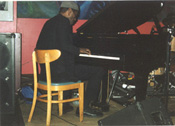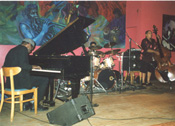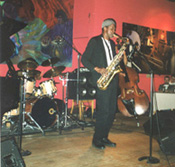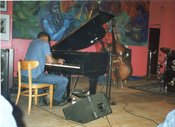| |
Charles
Gayle Trio + Matthew Shipp Trio
Chicago IL, 1 September 2000
by Derek Taylor
September 2000
 In the eight years I've been aware of Charles Gayle's music I've had
six opportunities to hear him in concert. Prior to catching the date
recounted here, five out of those six had been met with defeat stemming
from a variety of circumstances, most common among them a cancelled
performance. On this sixth attempt my luck finally came through and
I finally caught the man in person. The performance he delivered was
more than worth the stings of previous disappointments. In the eight years I've been aware of Charles Gayle's music I've had
six opportunities to hear him in concert. Prior to catching the date
recounted here, five out of those six had been met with defeat stemming
from a variety of circumstances, most common among them a cancelled
performance. On this sixth attempt my luck finally came through and
I finally caught the man in person. The performance he delivered was
more than worth the stings of previous disappointments.
Descending
upon the Hothouse, one of downtown Chicago's most decorative and
personable jazz clubs, Gayle's entrance was more like a whisper than
a roar. Spotting him enter and make a beeline for a shadowy corner
across the bar I approached him to ask whether he would mind me taking
photos of his performance. He nodded agreement and we shared a brief
conversation before I hastily returned to my seat. Bassist Harrison
Bankhead and drummer Avreeyal Ra arrived shortly after and the three
convened on the stage in front of a modest audience, which was soon
to grow to a sizeable crowd. After brief announcements that included
the startling revelation that it had been seven years since Gayle's
last Windy City engagement, the stage lights dimmed and Gayle took
his place at the piano stool.
 Though
piano is his first instrument, Gayle's work behind the keyboard has
never been lauded by the critics. Based on the atrophied interplay
that characterizes Illuminators, his recording with Sunny Murray,
it's easy to see why the applause has been so reticent. While containing
arresting playing from both musicians the session is very much akin
to listening to two players in separate rooms. For the most part such
was fortunately not the case in the company of Bankhead and Ra. Gayle
started out soft, pressing plaintive, blocky notes between the cymbal
swish of Ra and the stray bass throbs of Bankhead. Soon the intensity
quickened and Gayle turned to splashes and flurries stabbing out Cimmerian
chords in stuttering stops and spurts. Ra, galvanized by the shift
in energy, upped the ante in a cloudburst of thunderous drums. Gayle's
simple staccato patterns, designed presumably to hammer the eardrums,
answered as his feet worked the pedals building cavernous sustain.
After a short and checkered solo he dropped out leaving Ra to make
prodigious use of bass drum with cowbell accents before a brief ensemble
reentry. Though
piano is his first instrument, Gayle's work behind the keyboard has
never been lauded by the critics. Based on the atrophied interplay
that characterizes Illuminators, his recording with Sunny Murray,
it's easy to see why the applause has been so reticent. While containing
arresting playing from both musicians the session is very much akin
to listening to two players in separate rooms. For the most part such
was fortunately not the case in the company of Bankhead and Ra. Gayle
started out soft, pressing plaintive, blocky notes between the cymbal
swish of Ra and the stray bass throbs of Bankhead. Soon the intensity
quickened and Gayle turned to splashes and flurries stabbing out Cimmerian
chords in stuttering stops and spurts. Ra, galvanized by the shift
in energy, upped the ante in a cloudburst of thunderous drums. Gayle's
simple staccato patterns, designed presumably to hammer the eardrums,
answered as his feet worked the pedals building cavernous sustain.
After a short and checkered solo he dropped out leaving Ra to make
prodigious use of bass drum with cowbell accents before a brief ensemble
reentry.
Next up, Bankhead moved to the fore shaping a solo from a pulsing,
dissected ostinato line. Gayle sat at his stool, still as a statue,
head bent in rumination before his fingers flexed, shot forward, and
again crashed against the keys. Bankhead's accompaniment at this point
became so profuse that the flurry of notes streaming from his strings
lost definition and disintegrated in a clouded wave of excess. Seeming
to sense the upset, Gayle signaled an abrupt ensemble close.
The trio's second improvisation was far more lyrical in texture as
Gayle executed light trills across the keyboard flanked by Ra's light
brush accents. Bankhead's fingers were again a blur however and ill
fitting with the balladic nature of the piece. After what looked
like a missed visual cue the three came to an awkward close. With
the third improvisation Gayle again changed things up opening with
a jaunty bouncing theme over a clip-clop march-like cadence from
Ra and a walking line from Bankhead. Seemingly oblivious to his partner's
rhythmic subtleties Gayle plowed right on through with a stride-like
progression and several fractured trips down the length of the keyboard.
Ra took an open opportunity for a solo on brushes and Bankhead finished
things off with another strum fest. By this point I found myself
eyeing the black saxophone case resting against Gayle's stool with
increasing anticipation.
 The group's
fourth improvisation erupted at full tilt hitting a furious pace
from the start. Ra was a dervish behind his kit banging out a volley
of rhythms that continually rose in intensity. Gayle worked the harmonic
end of the piece moving from tension to release as Bankhead thrummed
out another furious counterpoint. After a brief solo by Gayle, Bankhead
unsheathed his bow for the first time and commenced to sawing in
a frenetic fashion similar to that of pizzicato work. At this juncture
Gayle rose from his stool, picked up his horn case and moved to the
back of the stage, standing in quiet and respectful contemplation.
Minutes later, his tenor pressed to his lips, he began to blow long
breathy tones which quickly coarsened into a unified Ayleresque shout.
As if conjoined by a shared electric current uncontrollable grins
crossed the countenances of the audience (myself included). Now things
were really getting somewhere. The group's
fourth improvisation erupted at full tilt hitting a furious pace
from the start. Ra was a dervish behind his kit banging out a volley
of rhythms that continually rose in intensity. Gayle worked the harmonic
end of the piece moving from tension to release as Bankhead thrummed
out another furious counterpoint. After a brief solo by Gayle, Bankhead
unsheathed his bow for the first time and commenced to sawing in
a frenetic fashion similar to that of pizzicato work. At this juncture
Gayle rose from his stool, picked up his horn case and moved to the
back of the stage, standing in quiet and respectful contemplation.
Minutes later, his tenor pressed to his lips, he began to blow long
breathy tones which quickly coarsened into a unified Ayleresque shout.
As if conjoined by a shared electric current uncontrollable grins
crossed the countenances of the audience (myself included). Now things
were really getting somewhere.
Rising
to the occasion Ra renewed his vigor on his traps. Gayle leaned back
on his heels stretching up, raising his shoulders and letting the
spirit flow through. Behind him Ra, a blur of sticks and appendages,
continued a charging rhythmic current. Unbeknownst to many, Roscoe
Mitchell and Leroy Jenkins had taken seats at a table close to the
stage and watching their beaming faces as Gayle blew the house down
added even further the celebratory atmosphere. Gayle continued for
a short spell at full speed before abruptly closing both the piece
and the set out to uproarious applause.
Twenty minutes later a shorter second set ensued, with Gayle starting
out on tenor and eventually moving back to piano for the conclusion.
The character of round two was somewhat anticlimactic, but Gayle still
managed to release a hoary rush of gospelized fervor with Bankhead
and Ra in close tow. Both of the rhythm men trod much the same ground
as in the initial pieces, but far from being redundant the vampish
nature of their contributions only bolstered Gayle's own statements.
 Shipp's
set, which followed, was something of a comparative disappointment.
Joining William Parker and Gerald Cleaver on the stage he sat patiently
at his stool as the former—dressed in red and black striped
dashiki, baseball cap and trousers—opened things up with a solo
pizzicato preface. Cleaver eventually joined in, followed closely
by Shipp who wasted no time in carving out dense pedal-altered clusters
arching forward in his signature hunchback style of concentration.
The density and velocity continued unabated for most of the remainder
of the set—a single, uninterrupted improv that had Shipp touching
on a range of thematic referents. Snatches of Monk, Ellington and
others bubbled up in the frothing spontaneous stew, but the unmitigated
opacity of the piece ultimately proved frustrating as well as exhausting.
Though there were numerous ear and eye opening solo sections by all
three players, and particularly Parker whose bow and fingers were
a constant flutter of activity, overall the set just couldn't maintain
its initial momentum to the finish. Shipp did provide a stunning contrast
to Gayle behind the keyboard, but for myself, and I think many others
who were still reeling in the throes of the latter's sermon, the monolithic
nature of his set was even more difficult to digest. It was a definite
thrill and privilege to witness both performances however; a sentiment
I'm certain was shared by all who were present. If those of us in
the Midwest are lucky both men will be back for return engagements
soon. Shipp's
set, which followed, was something of a comparative disappointment.
Joining William Parker and Gerald Cleaver on the stage he sat patiently
at his stool as the former—dressed in red and black striped
dashiki, baseball cap and trousers—opened things up with a solo
pizzicato preface. Cleaver eventually joined in, followed closely
by Shipp who wasted no time in carving out dense pedal-altered clusters
arching forward in his signature hunchback style of concentration.
The density and velocity continued unabated for most of the remainder
of the set—a single, uninterrupted improv that had Shipp touching
on a range of thematic referents. Snatches of Monk, Ellington and
others bubbled up in the frothing spontaneous stew, but the unmitigated
opacity of the piece ultimately proved frustrating as well as exhausting.
Though there were numerous ear and eye opening solo sections by all
three players, and particularly Parker whose bow and fingers were
a constant flutter of activity, overall the set just couldn't maintain
its initial momentum to the finish. Shipp did provide a stunning contrast
to Gayle behind the keyboard, but for myself, and I think many others
who were still reeling in the throes of the latter's sermon, the monolithic
nature of his set was even more difficult to digest. It was a definite
thrill and privilege to witness both performances however; a sentiment
I'm certain was shared by all who were present. If those of us in
the Midwest are lucky both men will be back for return engagements
soon.
|
|
|
|
|

